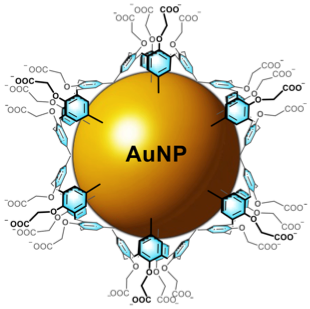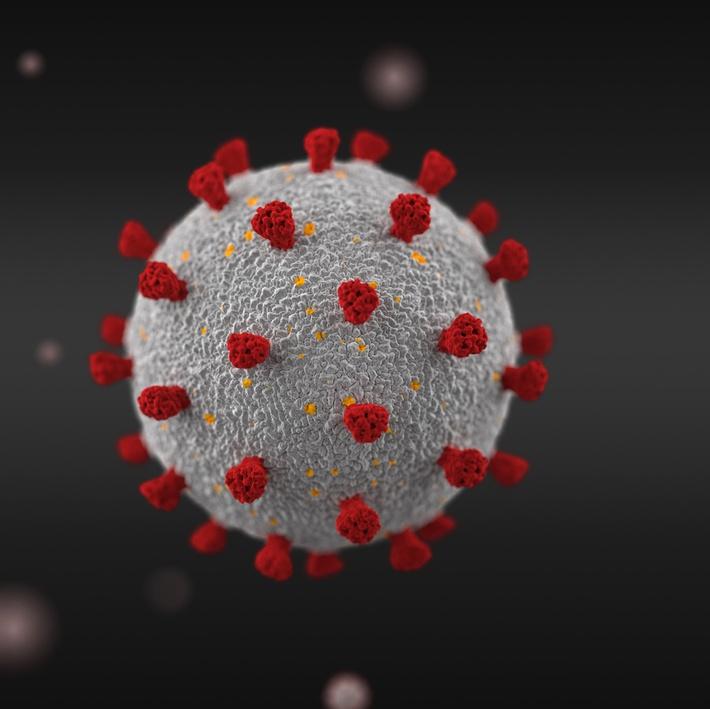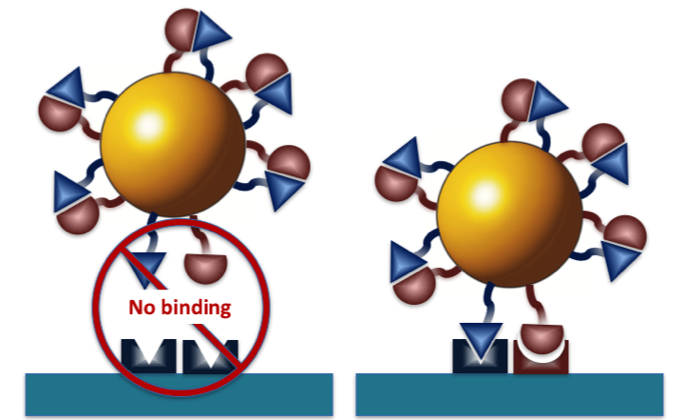In the same section
-
Share this page
Nanomaterials for sensing applications
#1 Controlled functionalization of gold nanoparticles

Head: Prof. Gilles Bruylants
Co-workers/researchers: Dr Hennie Valkenier, Dr Maurice Retout
Collaborations: Prof. Ivan Jabin (ULB, Laboratory of Organic Chemistry), Prof. Claire Mangeney (Paris-Descartes), Prof. Corinne Lagrost & Dr Yann Leroux (Université de Rennes 1)
Funding: ARC
Publications:
Synthesis of Ultrastable and Bioconjugable Ag, Au, and Bimetallic Ag_Au Nanoparticles Coated with Calix[4]arenes
Retout M., Jabin I. & Bruylants G., ACS Omega 6, 30, 19675-19684 (2021). OA
Ultrastable PEGylated Calixarene-Coated Gold Nanoparticles with a Tunable Bioconjugation Density for Biosensing Applications
Retout M., Blond P., Jabin I. & Bruylants G., Bioconjugate Chem. 32, 2, 290-300 (2021).
Limits of Thiol Chemistry Revealed by Quantitative Analysis of Mixed Layers of Thiolated-PEG Ligands Grafted onto Gold Nanoparticles
Retout M., Brunetti E., Valkenier H. & Bruylants G., Journal of Colloid and Interface Science 557, 807-815 (2019).
Controlled Functionalization of Gold Nanoparticles with Mixtures of Calix[4]arenes Revealed by Infrared Spectroscopy
Valkenier H., Malytskyi V., Blond P., Retout M., Mattiuzzi A., Goole J., Raussens V., Jabin I. and Bruylants G., Langmuir 33, 8253-8259 (2017).
Extremely robust and post-functionalizable gold nanoparticles coated with calix[4]arenes via metal–carbon bonds
Troian-Gautier L., Valkenier H., Mattiuzzi A., Jabin I., Van den Brande N., Van Mele B., Hubert J., Reniers F., Bruylants G., Lagrost C. and Leroux Y., Chemical Communications 52, 10493-10496 (2016).
#2 SUBLIMUS – Becoming modern green urban alchemists: Gold and silver mining from Brussels urban sewage

Head: Prof. Gilles Bruylants
Co-worker/researcher: Dr Carlos Moya
Collaborations: Prof. Marc Elskens, Prof. Philippe Clayes, Dr Natacha Brion (VUB), Ir Xavier Nicolay (LABiris)
Funding: INNOVIRIS - Bridge
Publications:
Atomic Force Manipulation of Single Magnetic Nanoparticles for Spin-Based Electronics
Burger P., Singh G., Johansson C., Moya C., Bruylants G., Jakob G. & Kalaboukhov A., ACSNano 16(11), 19253-19260 (2022).
Magnetic Self-Healing Composites: Synthesis and Applications
Cerdan K., Moya C., Van Puyvelde P., Bruylants G. & Brancart J., Molecules 27(12), 3796 (2022).
The Belgian TV show "Le grand Cactus" (Nov. 2019) was inspired by the SUBLIMUS project for one of their humorous sketches !
#3 Functionalized gold nanoparticles for amonium sensing in water
Ammoniums are ubiquitous in natural and synthetic compounds. Many possess high levels of toxicity and some are considered as potentially carcinogens. The aim of this project is to transfer homotrioxacalix[3]arenes, cavity-based receptors that exhibit remarkable binding properties in organic solvents towards primary ammonium ions, into water via their grafting onto gold nanoparticles. Our intention is to exploit these systems for the sensing of biologically relevant primary ammonium ions in water.
Head: Prof. Gilles Bruylants
Co-workers/researchers: Prof. Kristin Bartik, Ir Romain Carpentier
Collaborations: Prof. Ivan Jabin (ULB, Laboratory of Organic Chemistry)
Funding: FNRS - FRIA PhD Fellowship
#4 COVID-19 immunoglobulin detection tests

Promotors: Prof. Gilles Bruylants - Engineering of Molecular NanoSystems laboratory, EMNS ; Ivan Jabin - Organic Chemistry Laboratory, LCO ; Vincent Raussens - Structure and Function of Biological Membranes laboratory, SFMB.
Co-workers/researchers: Dr Maurice Retout (EMNS), Raphaël Dutour (EMNS), Bryan Gosselin (EMNS-LCO), Dr Ludovic Troian-Gautier (LCO), Pascale Blond (LCO-SFMB), Robin Bevernaegie (LCO)
Funding: ULB Special Fund COVID-19
Covid19@ULB: A new rapid detection test developed in the EMNS lab (17.12.20)
Publication:
Ultrastable Silver Nanoparticles for Rapid Serology Detection of Anti-SARS-CoV‑2 Immunoglobulins G
Gosselin B., Retout M., Dutour R., Troian-Gautier L., Bevernaegie R., Herens S., Lefèvre P., Denis O., Bruylants G. and Jabin I., Analytical Chemistry 94/20, 7383-7390 (2022).
#5 Development of a Mdm2 molecular sensor using a dual-trapping strategy with peptide aptamers functionalized gold nanoparticles

We are developing AuNP-based protein detection platform for the detection of Mdm2. The platform exploits a double recognition strategy using two sets of AuNPs, each functionalized with a different peptide aptamer. The two sets of particles are able to recognize the target protein simultaneously, via the formation of a ternary complex between the two peptides and the protein, inducing their aggregation. High selectivity is ensured by the dual-trapping mechanism.
Mdm2 was used as proof of concept of this strategy due to its strong biomedical interest, but similar peptide based dual-trapping recognition assays could be developed for other proteins. The properties of this platform (high selectivity, easy readout, efficiency of set-up, low cost) correspond perfectly with point-of- care expectations and such evolution will be envisaged. Efforts are on going to extend this system to other protein targets.
Head: Prof. Gilles Bruylants
Co-workers/researchers: Dr Maurice Retout
Collaborations: Prof. Thomas Doneux (ULB, Analytical and Interfacial Chemistry)
Funding: FER & Van Buuren (UV-Vis-NIR)
Publications:
Peptide-Conjugated Silver Nanoparticles for the Colorimetric Detection of the Oncoprotein Mdm2 in Human Serum
Retout M., Gosselin B., Mattiuzzi A., Ternad I., Jabin I. and G. Bruylants, ChemPlusChem 87(4),e202100450 (2022).
Rapid and Selective Detection of Proteins by Dual Trapping Using Gold Nanoparticles Functionalized with Peptide Aptamers
Retout M., Valkenier H., Triffaux E., Doneux T., Bartik K. and Bruylants G., ACS Sensors 1(7), 929-933 (2016).
#6 Use of multivalent targeting to develop superselective probes for biological systems

A simple approach to selective targeting consists of functionalizing the carriers with a single ligand that binds strongly to a single receptor only found on target cells. However, there are 200 different cell types in the human body and more than 10,000 different microbial species (mostly bacteria), and most of these can exist in a variety of physiological states. The fact that each cell can express many different surface receptors makes it extremely difficult to identify a receptor that is only present on the target cells.
Our goal is to take advantage of the complexity of cell membranes and design multivalent interaction schemes that are selective against a specific combination of many receptors that is likely to occur uniquely on the target. As proof-of- concept, we plan to test our strategy on synthetic model systems, in which liposomes, functionalized with DNA oligonucleotides, will mimic cells and nanoparticles, functionalized with the complementary strands, will serve as probes. We envisage exploiting the competition between “intra-probe loop complexes” and “probe-target bridges”. The free energy penalty of breaking a stable intra-probe loop complex can only be compensated if all of the ligands in the complex find their partner on the target cell, enabling to accurately select towards the simultaneous presence of multiple receptors.
Head: Prof. Gilles Bruylants
Co-workers/researchers: Dr Roberta Lanfranco
Collaborations: Prof. Bortolo Mognetti (ULB, Physics of Complex Systems and Statistical Mechanics), Prof. Pietro Cicuta (University of Cambridge, Cavendish Laboratory) and Dr Lorenzo Di Michele (Imperial College London)
Funding: Fondation Wiener-Anspach
Publications:
Adaptable DNA interactions regulate surface triggered self assembly
Lanfranco R., Jana P. K., Bruylants G., Cicuta P., Mognetti B. M. & Di Michele L., Nanoscale 12, 18616-18620 (2020).
Kinetics of Nanoparticle-Membrane Adhesion Mediated by Multivalent Interactions
Lanfranco R., Jana P. K., Tunesi L., Cicuta P., Mognetti B. M., Di Michele L. and Bruylants G., Langmuir 35(6), 2002-2012 (2019).
